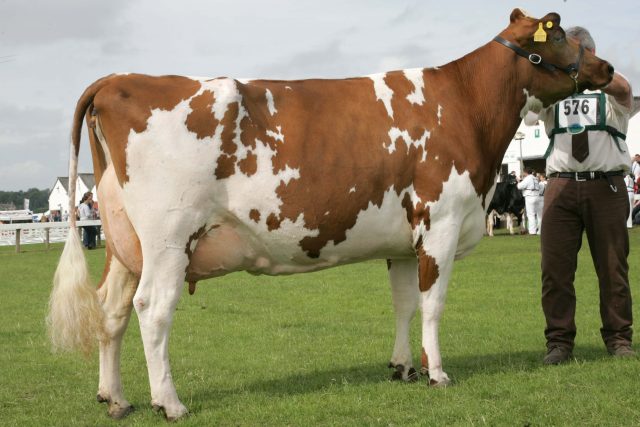Type the name of the breed you're looking for below
[wpdreams_ajaxsearchlite] Don't see the breed your're looking for? Click here and let us know!
Ayrshire cattle
| Place of Origin | Scotland |
| Origin | The Ayrshire breed originated in the County of Ayr in Scotland, prior to 1800 and was regarded as an established breed by 1812. During its development, it was referred to first as the Dunlop, then the Cunningham, and finally, the Ayrshire. How the different strains of cattle were crossed to form the breed known as Ayrshire is not exactly known. There is good evidence that several breeds were crossed with native cattle to create the foundation animals of the breed. In Agriculture, Ancient and Modern, published in 1866, Samual Copland describes the native cattle of the region as "diminutive in size, ill-fed, and bad milkers." Prior to 1800 many of the cattle of Ayrshire were black, although by 1775 browns and mottled colours started to appear. The improvement of the native stock is thought to of begun around 1750 when it was crossed with other breeds such as the Teeswater cattle and Channel Islands cattle. Regardless of the details of origin, the early breeders carefully crossed and selected the various strains of cattle to develop the cow we now know as the Ayrshire. She was well suited for the land and climate in Ayr. The Ayrshire is an efficient grazer; noted for her vigour and efficiency of milk production. Ayrshire's are especially noted for the superior shape and quality of the udder. The composition of the milk made it ideally suited for the production of butter and cheese by the early Scottish dairymen. Many changes have taken place during the late 1980's and early 1990's which have affected the numbers of Ayrshires (and all other breeds) leading to a decrease. Much of this is due to increased profitability of all dairy cows, which has led to an over-supply of milk to the domestic market. However, careful management has convinced Ayrshire breeders that their chosen breed has served them well, and will continue to do so in the future. |
| Purpose | Dairy, with exceptional foraging ability. |
| Appearance | Ayrshires are red and white, and purebred Ayrshires only produce red and white offspring. Actually, the red colour is a reddish-brown mahogany that varies in shade from very light to very dark. On some bulls, the mahogany colour is so dark that it appears almost black in contrast to the white. There is no discrimination or registry restriction on colour patterns for Ayrshires. The colour markings vary from nearly all red to nearly all white. The spots are usually very jagged at the edges and often small and scattered over the entire body of the cow. Usually, the spots are distinct, with a break between the red and the white hair. Some Ayrshires exhibit a speckled pattern of red pigmentation on the skin covered by white hair. Brindle and roan colour patterns were once more common in Ayrshires, but these patterns are rare today. |
| Horns | Medium, lyre-shaped. |
| Cows Average Weight | 450 - 600 kg (990 – 1,320 lbs.) |
| Bulls Average Weight | 635 - 900 kg (1,400 – 1,984 lbs.) |
| Other Considerations | Ayrshires are found in most parts of the world. Ayrshires in Southern Africa are used for the company Woolworths, which replaced Simmental Cattle in 1988. In New Zealand, they are still called Dunlop Cattle. There are some Ayrshires in the Drakensberg and the Transvaal. Ayrshires are also widely farmed in Australia. There are some Ayrshires in the tropics, such as Malaysia, Sri Lanka, and parts of Africa. There are also Ayrshires in Scotland and Finland. As mascots; Most Ayrshire mascots are cartoons and plush toys, the mascot of the New Zealand company called Calci-yum, in one picture, she is standing on the tracks next to an NZR Ab class. There is another one from South Africa, a cartoon Ayrshire drinking milk, mainly in the flavoured milks. |



